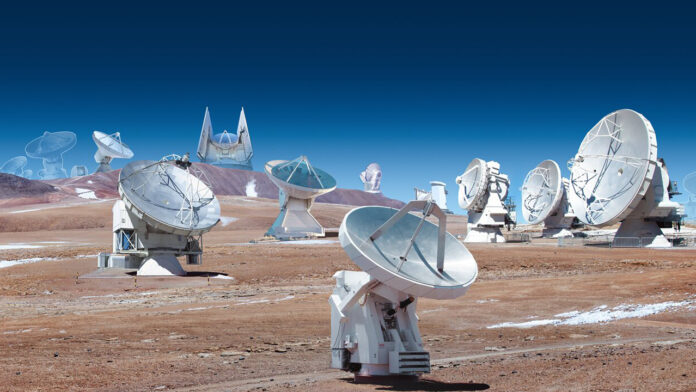In the vast cosmic expanse, the Event Horizon Telescope (EHT) stands as a technological marvel and a symbol of international scientific collaboration. This groundbreaking initiative has provided humanity with unprecedented insights into the enigmatic realm of black holes. In this article, we embark on a cosmic journey to explore the fascinating facts, intricate science, and astounding achievements of the Event Horizon Telescope.
The Quest to Capture the Unseen
Understanding Black Holes: Black holes, cosmic entities with gravitational forces so strong that nothing, not even light, can escape their grasp, have long been a mystery. The EHT aims to unveil the secrets of these celestial objects, especially the region known as the event horizon, the boundary beyond which nothing can escape a black hole’s gravitational pull.
The Challenge of Imaging Black Holes: Imaging black holes is an astronomical challenge due to their immense distances from Earth and the limitations of traditional telescopes. The EHT, however, employs innovative techniques and an array of telescopes worldwide to overcome these hurdles.
The Global Collaboration
Telescopes Around the World: The EHT is not a single telescope but a global network of radio telescopes strategically positioned across the Earth. These telescopes, including the Atacama Large Millimeter/submillimeter Array (ALMA) in Chile and the South Pole Telescope, work in unison using a technique called interferometry to create a virtual Earth-sized telescope.
International Consortium: The EHT represents an unprecedented level of international collaboration, involving scientists and astronomers from multiple countries and institutions. This global effort pools resources, expertise, and data to achieve a unified goal: capturing the first-ever image of a black hole.
The Technological Marvel of Interferometry
Interferometry Explained: Interferometry is a technique that combines the signals received by multiple telescopes to create a composite image with a level of detail impossible to achieve with a single telescope. In the case of the EHT, this technique allows astronomers to mimic the resolution of a single telescope as large as the Earth.
Synthesizing Data: The EHT records massive amounts of data from each telescope, and sophisticated algorithms are employed to synthesize this data into a cohesive and detailed image. The resulting images provide a closer look at the regions surrounding black holes than ever before.
The Historic Black Hole Image
M87 Black Hole:* In 2019, the EHT made history by capturing the first image of a black hole, located in the center of the galaxy M87. This supermassive black hole, known as M87*, is approximately 55 million light-years away from Earth.
The Image’s Significance: The iconic image, resembling a glowing, ring-like structure surrounding a dark void, offered visual confirmation of the existence of black holes and provided valuable data for scientists to test and refine theories related to general relativity and the nature of spacetime.
The Science Behind the Image
General Relativity Confirmation: The EHT’s observations of M87* align with predictions made by Albert Einstein’s theory of general relativity. The bending of light around the black hole, as observed in the image, confirms the gravitational effects described by Einstein over a century ago.
Understanding Galactic Nuclei: The EHT’s discoveries extend beyond individual black holes. By studying the behavior of matter around these cosmic giants, scientists gain insights into the dynamics of galactic nuclei, the central regions of galaxies where supermassive black holes reside.
Challenges and Innovations
Data Processing Challenges: Processing the colossal amount of data collected by the EHT poses significant challenges. Advanced algorithms and supercomputers are employed to meticulously analyze and synthesize the data, allowing astronomers to construct high-resolution images.
Global Synchronization: Synchronizing observations from telescopes around the world is a feat of precision. The EHT team must account for factors such as Earth’s rotation and atmospheric conditions to ensure that the telescopes are precisely aligned during data collection.
Black Holes and Beyond
Continued EHT Observations: The success of the EHT’s M87* observations has spurred ongoing efforts to capture images of other black holes. As technology advances and the EHT network expands, astronomers anticipate further groundbreaking revelations about these cosmic enigmas.
Contributions to Astrophysics: The EHT’s contributions extend beyond black hole imaging. The data collected enhances our understanding of fundamental astrophysical processes, including the behavior of matter under extreme gravitational conditions.
Public Engagement and Outreach
Educational Initiatives: The EHT engages in extensive educational outreach programs to share its discoveries with the public. Educational materials, public lectures, and interactive resources aim to inspire the next generation of astronomers and science enthusiasts.
Global Interest and Impact: The release of the first black hole image captured the world’s imagination. The EHT’s discoveries have not only advanced scientific knowledge but also sparked widespread interest in astrophysics and the mysteries of the universe.
The Future of Event Horizon Telescope
Advancements in Technology: The EHT continues to push the boundaries of technology. Ongoing developments in telescope technology, data processing, and global synchronization will further enhance the capabilities of the EHT in unraveling the secrets of the cosmos.
Expanding the Network: Plans to expand the EHT network involve adding more telescopes to improve resolution and increase the frequency range of observations. These expansions promise to open new frontiers in our exploration of black holes and their cosmic surroundings.
Conclusion: A Cosmic Triumph of Human Ingenuity
In conclusion, the Event Horizon Telescope stands as a testament to human ingenuity and collaboration, pushing the boundaries of what we can observe and understand in the vastness of space. From capturing the first image of a black hole to advancing our knowledge of astrophysics, the EHT continues to rewrite the cosmic narrative. As we gaze into the cosmic abyss, the revelations brought forth by the Event Horizon Telescope inspire awe and curiosity, inviting us to journey deeper into the mysteries of the universe.

